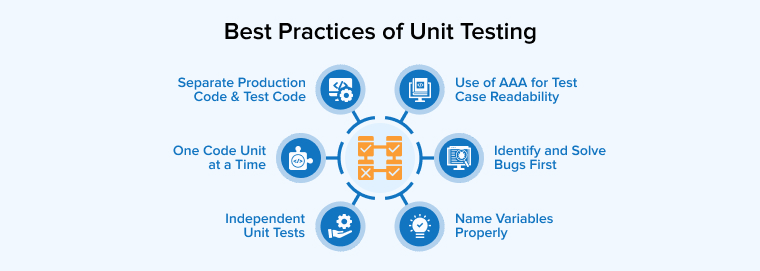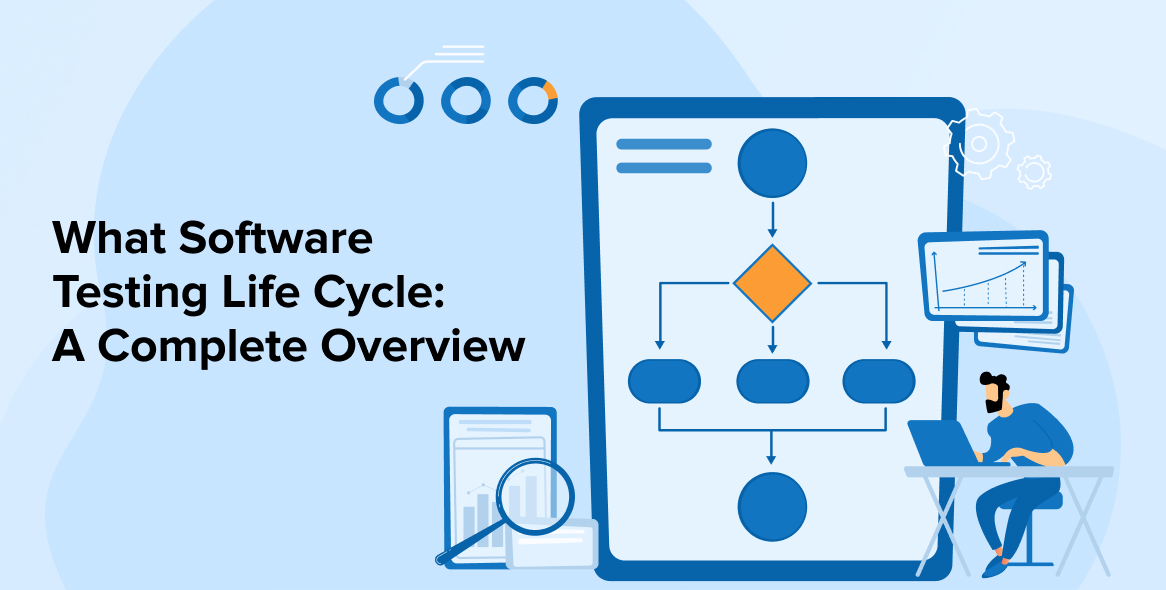
While creating software for the client, the most important step to follow in the software development life cycle is to test it perfectly. And the very first step of software testing is Unit testing. It is a process that creates small testable parts of the software known as units and then tests them individually for proper operation. This approach of testing is carried out by many software testing companies and quality assurance experts while the development process is going on.
To know more about unit testing, its process, types, and more, let’s go through this blog.
1. What is Unit Testing?
Unit testing is one of the most popular types of software testing approach in which individual functions or units of the software are tested. The main goal of this type of testing is to check each function or unit of the system. By unit, it means smaller parts of the application that can be tested. And there are a few procedures and inputs for a single output. Basically, unit testing checks the smallest parts of code that can be logically isolated in a solution. And in most object-oriented programming languages, it is a method, a function, or a subroutine.
1.1 Purpose of Unit Testing
The software development process is not complete without unit testing. Execution issues are more likely to arise if unit tests are not performed or are performed poorly, requiring more time, expense, and people to address. Unit testing aims to do a number of things, including:
- To ensure that a particular piece of code is correct.
- To divide a piece of code into distinct parts.
- The goal is to find and fix problems with the program as soon as possible.
- Improve the developer’s familiarity with the code base.
- The ability to make adjustments quickly and painlessly.
- Improve the viability of code reuse.
1.2 Advantages of Unit Testing
Some of the major advantages of the unit testing framework are –
- Unit testing enables developers to refactor code and ensures that the module is working correctly.
- It is easy to use and learn and because of that, any developer can just look at the unit tests to understand the process.
- Its modular nature enables the testing of small parts of the project.
1.3 Disadvantages of Unit Testing
Some of the major disadvantages of the unit testing framework are –
- This method focuses on a unit of code that prevents it from catching integration errors.
- Unit testing doesn’t catch every error of the application.
1.4 Why is Unit Testing Important?
Unit testing is a process in which a group of software program modules or components are tested individually. And this process helps in validating the code’s accuracy by considering mock objects, stubs, drivers, and frameworks. And as unit testing is practiced at the starting phase of the process, this technique also helps in identifying and fixing bugs at the very beginning of the SDLC. And in this type of testing process, developers can save a lot of time.
Besides this, unit testing enables the app development teams to understand the solution’s codebase very clearly, reuse the code, validate the code’s correctness, and also make the code changes faster. And with the proper practice of unit testing, the testers and developers can save a lot of time in checking the bugs and fixing them at the initial phase of testing.
2. How Does Unit Testing Work?
Unit testing is a process that compresses three different stages – Plan, Cases, and Scripting. In the very first step, the unit test is planned, prepared, and reviewed. Then, the test scripts and cases are prepared so that the code can be tested perfectly. Basically, the test-driven development approach requires the developers to first write failing unit tests. And after that, the development team will write test cases and refactor the application till the test passes.
Besides, in unit testing, each test case is independently tested, in an isolated environment. This ensures the code’s lack of dependencies. And the software developer must code the criteria to verify test cases and for this one can also use a testing framework. Later, the developers must write test cases that focus on the code which affects the software’s behavior.
Basically, unit testing comes with characteristics that are important to perform under any test. And these aspects help the developers to modify the source code without any concerns about the changes that might affect the software’s functioning. And this is why unit testing is known as the most efficient and error-free process to test the programs.
3. Types of Unit Testing
Some of the most popular types of unit testing frameworks are –
3.1 White-Box Testing
White-box testing means transparent or glass-box testing that enables the testers to be aware of all the internal functionalities of the software. And the internal structure of the function to be tested is completely unknown.
3.2 Black-Box Testing
Black-box testing is a concept where the testes are unaware of the internal functionality of the project and the internal structure of all the system functions is also unknown.
3.3 Gray-Box Testing
Gray-box testing is an approach that is semi-transparent. It is known as a combination of both white-box and black-box testing. It is a type of system testing where the tester is aware of the internal functionality of any unit or test method but not as much as a white-box tester. This means that the testing team is partially aware of the project’s internal functionality.
4. How to Do Unit Testing?
When it comes to starting Unit Testing, developers create a part of code that can be used to test a specific function in software. They also isolate the function to perform unit testing in a more rigorous manner and this helps in revealing unnecessary dependencies between other units and the function or unit being tested by the team. And this can be eliminated at an earlier stage. Generally, software developers use a unit test framework to create automated unit tests for this method.
There are two main types of Unit Testing and they are –
- Manual Unit Testing
- Automated Unit Testing
Generally, unit testing is automated testing but it can also be performed manually if the project requires it. Here are the steps that are performed by the unit testing team –
- The process starts when the developer writes a small code in the app to test the app’s functions and this code can be later commented out or removed when it’s time to deploy the app.
- The development team can also isolate the function to rigorously test it. And this can be a thorough unit testing practice that comes with copying and pasting code to its own environment.
- Any programmer would use a unit test framework to develop automated test cases. And with the use of such automated frameworks, the developers code criteria into all the different types of tests to verify the correctness of the project’s source code. In addition to this, while the execution of the test cases in the process, the framework creates a log of all the failing test cases.
- To perform perfect unit testing, the testers follow the workflow that starts with creating test cases, reviewing them, creating a baseline of the tests, and then ends by executing unit test cases.
5. Unit Testing Techniques
Unit Testing Methods are generally divided into three categories: Black box testing, which includes evaluating the user interface alongside input and output; White box testing, which assess the functional characteristics of the software program; and Gray box testing, which is employed to perform test suites, test methods, test cases, and conduct risk assessments.
The following strategies are used in Unit Testing for code coverage:
- Condition Coverage
- Decision Coverage
- Statement Coverage
- Branch Coverage
- Finite State Machine Coverage
6. Best Practices of Unit Testing

6.1 Independent Unit Tests
When it comes to performing unit testing techniques, the developer or tester has to be sure about keeping the tests independent from each other. If the unit test cases are dependent, they will affect each other, and then any type of change can affect the tests. Besides, it can also increase the level of complexity of the test cases. Therefore, keeping them independent is the best thing to do.
6.2 One Code Unit at a Time
While checking a unit of code, the testers must look at each case in a different manner even if the unit test cases are related to each other. This is important as it will simplify the coding and refactoring process for the team members.
6.3 Use of AAA for Test Case Readability
AAA means Arrange, Act, and then Asset the test cases. It helps in separating the cases that are being tested from the steps like arranging and asset. Therefore, it helps in almost eliminating the inter-mix of the assertions and this is possible with the help of another A, i.e; Act. Basically, following this approach, enables the creation of the test suite readability.
6.4 Identify and Solve Bugs First
One of the best practices of unit testing is to identify the bug and fix it before the testing moves to another phase known as integration testing. Where integration tests identify the pieces of code working properly or not.
6.5 Name Variables Properly
When it comes to unit tests, the most important thing to do is name the variables properly. This helps in avoiding the usage of magic strings and makes everything clear.
6.6 Separate Production Code & Test Code
While writing unit tests, the developer must make sure that the code of the test is not deployed with the source code.
7. Best Tools For Unit Testing

Some of the best unit testing tools to help developers are –
- Junit: Junit is a popular unit testing tool that is free to use and it is mostly used by developers to check the apps written in Java programming language. This tool offers assertions to the identify test method of the system.
- PHPUnit: PHPUnit is majorly used by PHP developers. This tool takes small parts of the code and tests each of them differently.
- NUnit: NUnit is mostly used by developers working on .NET languages. It is a popular tool for writing manual scripts.
- EMMA: EMMA is another open-source tool that is used for the Java language. It helps the developers in analyzing and reporting code. It also supports coverage types like basic block, method, or line.
- JMockit: JMockit, a unit testing tool is open-source and is used for mocking APIs with verification syntax and recording.
8. Conclusion
To offer a qualitative and bug-free software solution to the clients, the software development team takes the system through a proper testing process and this includes applying unit testing at the initial stage. Unit testing focuses on the code of the system and separates the small modules of the program and tests them individually. Basically, unit testing helps in testing code and fixing the bug before the rest of the software development life cycle is carried forward. This type of software testing ensures that the developed system is quality assured and bug-free.






Comments
Leave a message...